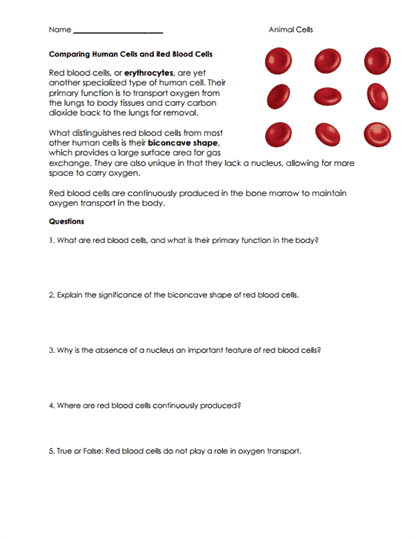Comparing Human Cells and Red Blood Cells

Worksheet Description
This worksheet delves into the specifics and functions of red blood cells, also known as erythrocytes, distinguishing them from other human cell types. It highlights the vital role of red blood cells in transporting oxygen from the lungs to body tissues and ferrying carbon dioxide back to the lungs for exhalation. The unique biconcave shape of these cells and their characteristic absence of a nucleus are emphasized. A series of questions encourages students to further explore and understand the intricacies of red blood cell function and structure.
Red blood cells, or erythrocytes, are yet another specialized type of human cell. Their primary function is to transport oxygen from the lungs to body tissues and carry carbon dioxide back to the lungs for removal.
What distinguishes red blood cells from most other human cells is their biconcave shape, which provides a large surface area for gas exchange. They are also unique in that they lack a nucleus, allowing for more space to carry oxygen.
Red blood cells are continuously produced in the bone marrow to maintain oxygen transport in the body.
To adeptly work through this worksheet, students should start by carefully reading the provided description, ensuring a clear understanding of the specific traits and roles of red blood cells. The accompanying images act as visual references, assisting in correlating the written content with the actual appearance of the cells. Once the primary information has been comprehended, students can address the questions, referencing the main text for accurate and informed answers. A post-completion review of their answers against the descriptive section will validate their understanding and rectify any misconceptions.
The worksheet is crafted to instill in students a nuanced understanding of the unique attributes and critical role of red blood cells within the human body. By elaborating on specialized features, such as the biconcave shape, the material illuminates how these characteristics optimize oxygen and carbon dioxide transport. The absence of a nucleus in red blood cells, another focal point, is explored in the context of maximizing space for carrying oxygen. Through the posed questions, students are encouraged to apply their acquired knowledge, fostering a deeper appreciation for the complexities and indispensability of red blood cells in physiological functions.
